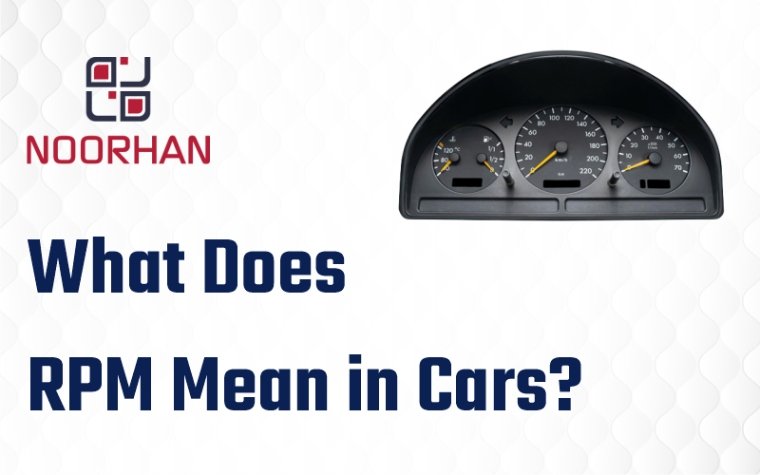What Does RPM Mean in Cars?
The number of revolutions per minute is called the Revolutions per Minute (RPM) number. It is a way to measure the speed or frequency of movement around a fixed centre. Rpm is not a measure in the International System of Units. Because “revolution” describes how something operates, it cannot be measured. The note is written as a subscript under the formula sign if needed.
Most of the time, the RPM is used to figure out when to change gears. Generally, it would help to change gears when the RPMs are low to save fuel and when they are medium to high to speed up. The RPM is very important because it tells you when to change gears. This keeps the engine and clutch from getting damaged. Especially new drivers may need help knowing when to change gears. The speedometer helps them choose and keeps engine parts from getting hurt.
What is a RPM in Cars?
When you press the accelerator button, the engine speed goes up, and the power goes up, at least to some degree. Most power doesn’t always come from a motor’s top speed. Most of the time, the biggest horsepower number comes first, followed by the rate at which it happens, like 252 hp at 5,600 rpm. Torque, a measure of the engine’s instantaneous turning force, is typically found at lower rpm in turbocharged or supercharged engines and may be reported in a range, such as 273 pound-feet at 1,600-4,500 rpm.
A tachometer is a tool that shows how many times an engine turns per minute (rpm). The red line is generally indicated by a red line at the top of the tachometer’s range. If the motor is revved past its red line, it can be hurt. Automatic transmissions are set to shift before the engine speed reaches that point, so only cars with manual transmissions need to worry about this. This will also change based on how hard you press the gas pedal.
The speedometer is no longer needed because an automatic gearbox will shift at the engine speed, which gives the best mix of efficiency and smoothness during the normal drive. The tachometer can assist manual transmission drivers in discovering this on their own. A rev limiter keeps the engine from revving to the red line in later cars with manual transmissions. This avoids damage, but it’s up to the driver to recover from the sudden stop and shift to a higher gear.
What does RPM mean when it comes to cars?
In cars with manual gearboxes, RPM is a very important number. But RPM is less important in cars with automatic gearboxes because the car automatically figures out the number of turns and adjusts the gearbox to slow or speed up the car based on that.
RPM is important in cars with manual transmissions because of the following.
The RPM counter tells the driver when to change gears to go faster or slower by showing the number of turns per minute.
Changing gears based on RPM can keep your engine and gearbox from getting too hot and breaking.
Speed changes feel smoother when driving if you pay attention to the RPM numbers.
RPM helps you determine how well your car’s engine is running, so you can do repairs on time and make the engine last longer.
How does RPM work with an engine?
When you press the gas pedal, more power is put into the engine, which makes it spin faster. But the engine’s top RPM sometimes means putting out the most power.
When choosing what kind of car you need, knowing the top horsepower and RPMs is important. A high torque number is important for low-speed performance, like hauling and pulling. Most torque happens at lower RPMs, so these cars are set so that their most powerful speeds happen at lower RPMs.
On the other hand, racing and speed cars may have less torque but more horsepower. For faster engine speeds, these cars are set to have the most power at high RPMs. This will make the concrete marks go by quickly as you change gears, the RPMs go up, and the engine strengthens.
When looking for a new car, the specs sheet usually shows the engine RPM and horsepower. The maker tells you how many rounds per minute the car can go at its most powerful level. Add these two figures to determine the car’s drivetrain performance.
What effect does RPM have on a car?
Let’s say you’re in 4th gear and going 80 km/h. almost likely, if you have 5 or 6 gears, your engine is working harder than it needs to. The engine will be louder than normal, and the speedometer will probably be between 4,000 and 5,000 RPM.
If you shift into 5th or 6th gear, your RPM will go down, but the car will still move at the same speed. You used the gears to get better gas mileage.
Always driving at high RPM strains your engine. Because you’re doing more work and using more gas, you’ll have to stop more often to fill up. However, keeping your RPMs low will save gasoline and reduce fuel stops.
There are, of course, times when this rule doesn’t apply. It’s normal for your RPMs to suddenly go up when you speed up quickly or drive up a steep hill. Just ease off the gas once you’re at cruising speed or have hit a steady state. That way, you’ll use less gas without losing performance.
Advantages of RPM: Why Does it Matter
RPM is the first step to optimising your vehicle. This is very true for people who drive cars with manual transmissions. Keep an eye on the RPM needle to know when to shift to get the most power.
You can focus on making the car as efficient as possible instead of making as much power as possible for a fast engine speed. Less gas is used when you drive at lower RPMs, which makes it more efficient. Maintaining higher RPMs improves gas mileage.
Even though new automatic cars are set up to shift at the right time, it’s still good to know your engine’s RPMs. If the engine RPMs aren’t normal, it could mean that something is wrong with how the car works.
If the RPMs jump up and down when you accelerate, it could mean that the spark plugs aren’t working right. RPM changes while moving could indicate several problems, like a jammed idle air control valve, a vacuum leak, or even major engine problems. If your car’s RPMs go up, but it doesn’t move faster, the gears or gearbox are slipping.
Lastly, a gas engine has many parts that move. The more movement caused by the RPMs, the more heat is made. Higher gears delay spins, reducing heat.
Knowing the RPMs of your engine will help it run better and last longer.
Wrap Up: What is RPM and Why Does it Matter?
The RPM gauge in a car is made to help you drive your car more smoothly. Race lovers and gas-savers who drive manual cars must watch the RPM. That’s why every car owner and driver needs to know what RPM is for to keep their cars running for a long time.
Where can you buy Best Auto Spare Parts in Dubai?
Auto Spare Parts are available at different suppliers and dealers of auto spare parts in Dubai. Noorhan is amongst the leading brands that deal with genuine auto spare parts and aftermarket parts for different car brands, including BMW, Mercedes, Audi, Porsche, Honda, Toyota, Nissan, Mazda, Jeep, Ford, and other Japanese, European, American, Korean, luxury cars brand.
If you’re looking to replace your old Auto Spare Parts with high-quality aftermarket parts in Dubai, Noorhan can help you.



























































